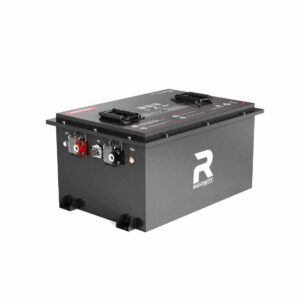What Are the Best RV Battery Types Advancing Safety Standards?
How Do RV Battery Types Differ in Safety and Performance?
RV batteries vary by chemistry: lead-acid (flooded, AGM, gel) and lithium-ion (LiFePO4). Lithium Iron Phosphate (LiFePO4) batteries lead in safety due to thermal stability, non-flammable electrolytes, and built-in Battery Management Systems (BMS). Lead-acid batteries risk leaks and gas emissions, while LiFePO4 offers longer lifespan, faster charging, and minimal maintenance, advancing RV safety standards.
Future of RV Battery Efficiency
| Battery Type | Cycle Life | Thermal Runaway Risk | Maintenance Needs |
|---|---|---|---|
| Flooded Lead-Acid | 300-500 cycles | Moderate | High (water refills) |
| AGM | 500-700 cycles | Low | Moderate |
| LiFePO4 | 3,000-5,000 cycles | Negligible | None |
Why Are Lithium Iron Phosphate (LiFePO4) Batteries Safer for RVs?
LiFePO4 batteries excel in safety with stable chemistry resistant to overheating, explosion, or thermal runaway. Their BMS monitors voltage, temperature, and current, preventing overcharging, deep discharges, and short circuits. Unlike lead-acid, they don’t emit hydrogen gas, eliminating fire risks in enclosed RV spaces. Redway Power notes, “LiFePO4’s robustness makes it ideal for rugged RV applications.”

The crystalline structure of LiFePO4 inherently resists oxygen release during charging, a critical factor in preventing combustion. This contrasts sharply with traditional lithium cobalt oxide batteries used in consumer electronics, which are prone to thermal runaway. RV owners also benefit from 80-100% usable capacity compared to lead-acid’s 50% limit, reducing deep discharge risks. Field studies show LiFePO4 batteries maintain 95% capacity after 2,000 cycles when properly managed by BMS—four times longer than AGM equivalents. Recent advancements include dual-layer separators between cells and ceramic-coated electrodes, further enhancing stability during sudden impacts common in RV travel.
What Safety Features Do Modern RV Batteries Include?
Advanced RV batteries integrate BMS, temperature sensors, flame-retardant casings, and pressure relief valves. Lithium models add cell balancing and短路 protection. AGM batteries use sealed designs to prevent acid leaks. These features mitigate risks like gas buildup, thermal events, and electrical faults, aligning with NFPA and RVIA safety standards.
How to Maintain RV Batteries for Optimal Safety?
Regularly inspect terminals for corrosion, ensure proper ventilation, and avoid overcharging. For lead-acid, check electrolyte levels and equalize charges. Lithium batteries require minimal upkeep but need firmware updates for BMS. Store batteries at 50% charge in cool, dry conditions. Use compatible chargers and monitor voltage with smart gauges.
Can Solar Integration Enhance RV Battery Safety?
Solar panels reduce reliance on generators, lowering fire risks from fuel. MPPT charge controllers optimize solar input, preventing overvoltage. Lithium batteries pair efficiently with solar due to high charge acceptance. Redway advises, “Solar-LiFePO4 systems cut carbon monoxide hazards and extend off-grid safety.”
What Emerging Technologies Are Improving RV Battery Safety?
Solid-state batteries, AI-driven BMS, and self-healing materials are emerging. Solid-state designs eliminate flammable liquids, while AI predicts failures. Graphene additives enhance thermal conductivity. Companies like Redway are testing “smart batteries” with real-time hazard alerts via IoT.
How Does Temperature Affect RV Battery Safety?
Extreme heat accelerates degradation and thermal runaway in lithium-ion (non-LiFePO4). Cold reduces lead-acid capacity and causes sulfation. LiFePO4 operates safely from -20°C to 60°C. Use insulated compartments and heating pads in freezing climates. Avoid charging below 0°C to prevent lithium plating.
Temperature extremes impact battery chemistry differently. Lead-acid batteries lose 35-40% capacity at -10°C, while LiFePO4 retains 85% performance. In desert conditions, internal BMS thermal cutoffs automatically disconnect power when cells exceed 65°C. Some manufacturers now embed phase-change materials in battery walls to absorb excess heat. For winter storage, LiFePO4’s self-discharge rate of 2-3% monthly outperforms AGM’s 5-15%, maintaining charge stability. Always prioritize batteries with IP67 or higher ratings for moisture and dust resistance during seasonal transitions.
Are Costlier RV Batteries Worth the Safety Investment?
LiFePO4 batteries cost 3x more than lead-acid but last 8-10 years vs. 3-5. Their safety ROI includes reduced fire risks, no maintenance costs, and energy efficiency. For full-time RVers, the upfront cost offsets long-term safety and reliability benefits.
“LiFePO4 is revolutionizing RV safety. Traditional batteries can’t match their stability or smart features. Pairing them with solar and robust BMS creates a failsafe power ecosystem. We’re integrating fail-safe disconnects and AI diagnostics to preempt faults before they escalate.” – Redway Engineer
FAQs
- Q: How often should I replace my RV battery?
- A: Lead-acid lasts 3-5 years; LiFePO4 lasts 8-10 years. Replace if capacity drops below 70%.
- Q: Can I mix different RV battery types?
- A: No. Mixing chemistries or ages causes imbalance, overheating, and reduced lifespan.
- Q: Are gel batteries safer than AGM?
- A: Gel batteries resist spills and handle vibration better but charge slower. AGM is safer for high-current applications.
